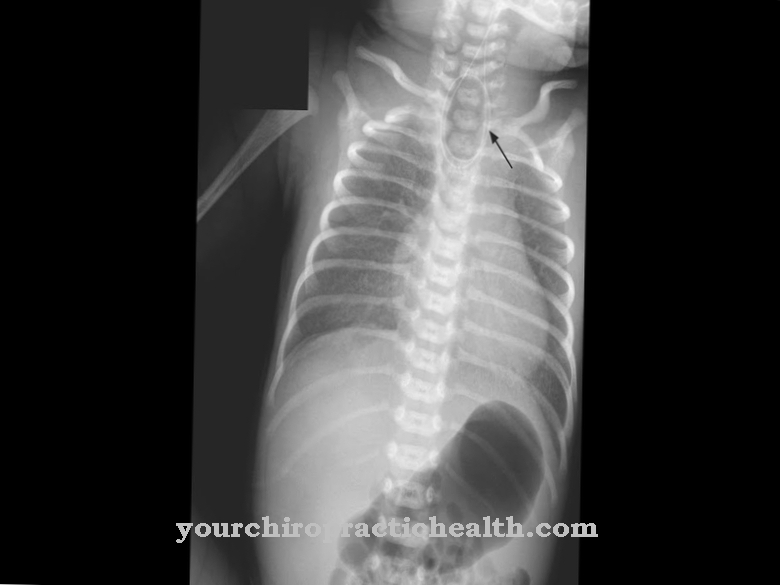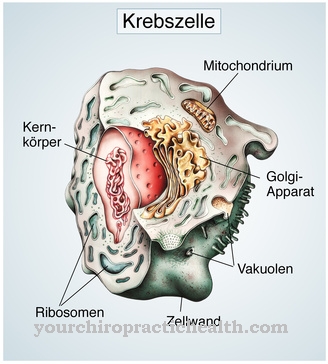The dilated cardiomyopathy describes a form of heart muscle disease in which the left ventricle in particular expands. Those affected suffer from cardiac arrhythmias and cardiac insufficiency. Most of the time it is not possible to cure dilated cardiomyopathy, only to alleviate the symptoms.
What is dilated cardiomyopathy?

© Alila Medical Media - stock.adobe.com
Dilated cardiomyopathy is a heart muscle disease. The term "dilate" comes from Latin and means to widen or expand. As a result, dilated cardiomyopathy is characterized by an enlargement of the heart cavities. As a result, the heart wall becomes slacker and more weak, which noticeably decreases the heart's pumping capacity.
In addition, it becomes stiffer and loses its elasticity, making it more difficult to fill the heart chambers with blood. Therefore, too little blood is pumped into the body's circulation, so that those affected complain of a significant reduction in physical performance. The structure of the heart muscle is changed and scar tissue can be penetrated.
causes
The causes of dilated cardiomyopathy are often very different and cannot be clearly identified. The most common cause known to trigger dilated cardiomyopathy is pronounced coronary artery disease.
In this case, the vessels are severely narrowed so that the heart muscle is not supplied with enough oxygen. Heart attacks are also common in these situations. As a result, remodeling processes occur in the functioning parts of the heart muscle, which often lead to the expansion of the left ventricle.
Other possible causes include infections of the heart muscle, cardiac arrhythmias and nerve disorders. Long-term, poorly controlled diabetes mellitus, amyloidosis (impaired production and deposits of proteins) or rare muscle diseases such as Duchenne muscular dystrophy (DMD) can trigger dilated cardiomyopathy.
Furthermore, excessive drug, alcohol and drug abuse (cocaine), genetic causes, various environmental factors or drugs that are used for chemotherapy can be the reason for one's heart disease.
Symptoms, ailments & signs
If there is a dilated cardiomyopathy, the patients often have the typical symptoms of heart failure (heart failure). Due to its limited performance, the heart does not manage to supply the organism with sufficient blood and thus oxygen. This is called forward failure.
In addition, heart failure is usually associated with backward failure. The blood builds up in the blood vessels that lead to the heart. The heart fails to work off the preload. Dilated cardiomyopathy manifests itself first of all with the typical symptoms of advancing left heart failure.
Those affected suffer from tiredness and decreased performance as well as a general feeling of weakness. Those affected also complain of shortness of breath, especially during physical exertion. In the case of an already very advanced dilated cardiomyopathy, the shortness of breath can also occur at rest.
Diagnosis & course
Dilated cardiomyopathy is diagnosed based on the symptoms described and a physical exam. Echocardiography (ultrasound examination of the heart) is the most important examination for clarification. This allows the size, shape, movement and pumping function of the heart to be assessed.
It is also possible to check the blood flow and thus the tightness of the heart valves. Furthermore, images of the heart structures can be delivered in a high resolution by means of magnetic resonance tomography. The tissue remodeling can also be assessed well in this way. If the diagnosis cannot be clearly established, a myocardial biopsy is performed.
A tissue sample is taken from the heart muscle and then examined under a microscope. If there is a dilated cardiomyopathy, typical heart muscle changes are found. In the course of the dilated cardiomyopathy often affects the right ventricle (global insufficiency).
In addition to the already existing symptoms, the patients then complain of fluid retention (edema), especially in the legs. Since the blood flow in the auricles and chambers of the heart is disturbed, blood clots form more easily in sick people than in healthy people. If this loosens, the arteries can become blocked.
The possible consequences are serious complications such as a pulmonary infarction or stroke. A progressive dilated cardiomyopathy can also lead to severe arrhythmias, circulatory collapse and in the worst case to sudden cardiac death.
Complications
The disease causes severe discomfort and disorders of the heart. In the worst case, these can even lead to the patient's death if heart failure occurs that is not properly treated. It is not uncommon for the cardiac arrhythmias to lead to an insufficient supply of blood to the organs, so that they are paralyzed or damaged.
Most of the time, those affected also suffer from a general feeling of weakness and tiredness. This cannot be compensated for by sleep. Even physically strenuous activities or sports can no longer be carried out without further ado, which severely restricts the everyday life of the person concerned and significantly reduces the quality of life. A circulatory collapse can also lead to sudden cardiac death.
The patient must avoid stressful situations and must not expose himself to unnecessary stress. A causal treatment is not possible, so there are no further complications. The heart usually needs to be protected and supported, and a pacemaker can also be installed. The disease reduces life expectancy in most cases.
When should you go to the doctor?
A doctor should be consulted in the event of shortness of breath, tiredness and a general feeling of weakness. Based on the symptoms described and an ultrasound examination of the heart, the doctor can determine whether a dilated cardiomyopathy is present and, if necessary, directly suggest a suitable therapy.
Occasionally an extended hospital stay is required for this. People who already have coronary artery disease, cardiac arrhythmias or nerve disorders are particularly susceptible to heart diseases such as dilated cardiomyopathy. Likewise, diabetics with poorly controlled treatment as well as amyloidosis and muscular dystrophy patients.
There is an increased risk of acute heart disease after excessive drug, alcohol, and drug use and the use of certain medications. Anyone who belongs to these risk groups should speak to the responsible doctor in any case if the symptoms are mentioned. In severe cases, the nearest clinic should be visited immediately.
If signs of a cardiac arrhythmia are noticed, the medical emergency service is the right contact. In the event of complications such as circulatory collapse and heart attack, the emergency doctor must be called in immediately. Until medical help arrives, first aid measures must be taken.
Doctors & therapists in your area
Treatment & Therapy
Dilated cardiomyopathy needs urgent treatment, but no therapy exists to treat the cause. If a possible cause, such as coronary artery disease, is known, it is important that it be treated. In addition, if possible, all drugs that can lead to heart muscle inflammation should be stopped.
The aim of therapy for dilated cardiomyopathy is to reduce the symptoms and curb the progression of the impaired pumping function of the heart. ACE inhibitors, diuretics, and digitalis preparations are usually given as medication. Beta blockers are sometimes used.
The dose is usually increased gradually so that the body and thus the heart are not unnecessarily stressed. Physical performance can be supported with a healthy and balanced, but low-salt diet. Obesity should be reduced and stress should be avoided. It is also advisable to avoid alcohol and nicotine, as these have a damaging effect on the heart muscle.
In addition, the amount of fluid must be reduced to 1.5 to a maximum of 2 liters per day, otherwise the heart is stressed too much. Sometimes surgery or the implantation of a pacemaker cannot be avoided. Dilated cardiomyopathy is ultimately an incurable disease.
Outlook & forecast
Dilated cardiomyopathy has a poor prognosis. Even under favorable conditions and the avoidance of various risk factors, the life expectancy of the patient is greatly reduced. The degree of heart failure is decisive for the course of the disease. Without the use of drug treatment, life expectancy is reduced by another.
The heart's activity can be stabilized and supported by the administration of medicines or the use of a pacemaker. The treatment measures are aimed at extending life and maintaining the accustomed quality of life for as long as possible.
Despite all efforts and the possibilities of scientific progress, a cure for this disease is currently not possible. Almost 90% of those suffering from dilated cardiomyopathy die within the first ten years of being diagnosed. The remaining 10% normally in the following five years.
The heart muscle disease leads to heart failure and ultimately to sudden cardiac death. Avoiding obesity, alcohol and nicotine can delay the progression of the disease.
The course of the disease can also be favorably influenced by not exercising too much physical strain, dealing with emotional challenges or reducing various stressors. Since the damage to the heart muscle cannot be corrected, the patient dies prematurely.
prevention
To prevent dilated cardiomyopathy, a healthy lifestyle and regular exercise are very important. The reduction of excess weight, the renouncement of nicotine and alcohol, a low blood pressure, the avoidance of stress and the prevention or treatment of diabetes or other metabolic diseases play an important role.
Aftercare
As a chronic heart disease, dilated cardiomyopathy must be given close follow-up care after acute care. This is carried out by the cardiologist or internist, usually in cooperation with the treating family doctor. Co-operation of the patient is absolutely necessary, since the way of life, as with other diseases of the heart, is also closely related to the condition and the course of the disease.
From a medical point of view, the regular checks must be observed. Ultrasound of the heart, stress ECG and imaging procedures such as MRI are among the classic examinations. Attending special cardiac sports groups can also be included in the follow-up care for dilated cardiomyopathy.
In everyday life, the patient can work on his fitness by integrating moderate physical activities into his daily routine. Sport should be discussed with the attending physician. Avoid excessive and insufficient demands. A healthy diet contributes significantly to the well-being of heart patients.
Little fat and avoiding flatulent foods are important here. It is also important to ensure that you drink enough water. Smoking must be avoided at all costs to protect the vessels. In addition, the consumption of alcohol is only permitted to a very limited extent. A sufficient amount of sleep is used for regeneration and is also important in the context of aftercare.
You can do that yourself
Everyday life and self-help to improve the living situation with a diagnosed dilated cardiomyopathy depend on the causal factors and the severity of the disease. Dilated cardiomyopathy is characterized by a widening of the left or right ventricle, which is usually associated with a reduction in the pumping capacity of the heart, which can lead to typical secondary diseases.
In addition to the necessary medication, an adaptation of the behavior in everyday life can help stop the progression of the disease and, depending on the severity of the disease, lead an almost unimpaired life.
Regardless of the cause of the disease, one of the most important measures is a change in diet to light, low-salt food. Possible and recommendable sports activities should be defined together with the doctor, which support the circulation and help to inhibit the further progress of cardiomyopathy.
Almost all other measures also serve as a preventive measure. First and foremost, the avoidance of chronic stress should be mentioned, because constant stressful situations lead to a high concentration of stress hormones via the sympathetic nervous system, which are no longer completely broken down and, among other things, are often the trigger for primary high blood pressure (hypertension).
High blood pressure should be avoided at all costs. In addition to medication, relaxation techniques such as yoga and meditation also help. It is also advisable to avoid being overweight and to avoid nicotine and alcohol as much as possible.


.jpg)






















.jpg)

.jpg)
